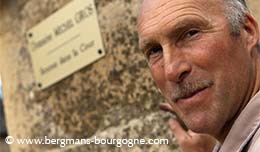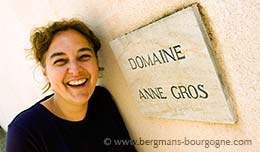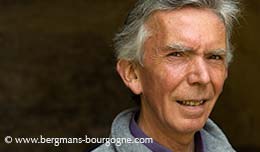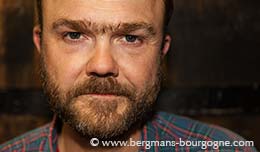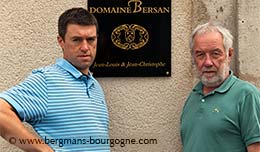
f you ask Olivier Lamy at Domaine Hubert Lamy in Saint-Aubin not much has happened the last few centuries.
– When it comes to making wine we haven't really invented anything, he says.
Still, there are quite a few things today at the domaine that are different from what they were when Olivier arrived in the 1990's. Production is now 80 per cent white and 20 per cent red. Four decades ago it was the other way around. Today the regional appellations are almost gone and there is an experiment with high density planting – 30 000 vines per hectare – going on in the Saint-Aubin premier cru Derrière Chez Edouard.
 When Hubert Lamy started out in 1973 most of the domaine's vines were in the regional appellations, such as Bourgogne Aligoté, Bourgogne Passetoutgrains and Bourgogne Hautes-Côtes de Beaune. As it turned out it was difficult to make enough money off these appellations, so eventually Olivier and his father started selling them, getting premier cru and village appellation land in and around Saint-Aubin instead.
When Hubert Lamy started out in 1973 most of the domaine's vines were in the regional appellations, such as Bourgogne Aligoté, Bourgogne Passetoutgrains and Bourgogne Hautes-Côtes de Beaune. As it turned out it was difficult to make enough money off these appellations, so eventually Olivier and his father started selling them, getting premier cru and village appellation land in and around Saint-Aubin instead.
– There has been Lamys in Saint-Aubin since at least 1640, says Olivier Lamy. Before that there are no records left. They were winegrowers, but they did not create big estates. What they had was usually split between the children for each new generation. My grandfather had seven hectares and seven children, so they all had to start out with only one hectare.
 Over the past two decades Saint-Aubin has gone from strength to strength. Quality has gone up and Saint-Aubin is now regarded as a, slightly less costly, alternative to the neighbouring villages of Puligny-Montrachet, Chassagne-Montrachet and Meursault. Land is still less expensive in Saint-Aubin, so for the price of a village appellation bottle from Puligny-Montrachet you will get a premier cru Saint-Aubin.
Over the past two decades Saint-Aubin has gone from strength to strength. Quality has gone up and Saint-Aubin is now regarded as a, slightly less costly, alternative to the neighbouring villages of Puligny-Montrachet, Chassagne-Montrachet and Meursault. Land is still less expensive in Saint-Aubin, so for the price of a village appellation bottle from Puligny-Montrachet you will get a premier cru Saint-Aubin.
– Nowadays we work our vineyards in exactly the same way as they do in Puligny-Montrachet or Chassagne-Montrachet, says Olivier Lamy. Ten or twenty years ago yields were higher. The winemaking is better today. In Saint-Aubin estates like Domaine Marc Colin and Domaine Larue have been making big investments in order to improve quality. Today many producers in the villages nearby buy land in Saint-Aubin because it is good value for money.
There is some Chassagne-Montrachet, Puligny-Montrachet and Santenay at Domaine Hubert Lamy, but the focus is on Saint-Aubin – one white village wine and nine premier crus, three red and six white. You will find Saint-Aubin in the valley just behind Puligny-Montrachet and Chassagne-Montrachet. Exposure varies from east to south. Many of the vineyards are very steep. Two hectares of the Domaine Hubert Lamy are so steep you can't use a tractor there; it's simply too dangerous.
 – In the premier crus the soil is between 20 and 40 centimetres deep, depending on the age of the rock, says Olivier Lamy. Higher up on the slope the rock is younger. At the bottom it is older. Depending on where on the slope you are you get different kinds of minerality in the wine. The exposure is also of importance. Southern exposure produces richer wines, eastern exposure fresher wines.
– In the premier crus the soil is between 20 and 40 centimetres deep, depending on the age of the rock, says Olivier Lamy. Higher up on the slope the rock is younger. At the bottom it is older. Depending on where on the slope you are you get different kinds of minerality in the wine. The exposure is also of importance. Southern exposure produces richer wines, eastern exposure fresher wines.
Up behind Saint-Aubin is Derrière Chez Edouard, a premier cru which produces both red and white for Domaine Hubert Lamy. The pinot noir vines at the bottom of the parcel were planted in 1960, the chardonnay vines at the top in 2000. This is also the place for Olivier Lamy's experiment with high density planting. In Burgundy the density is usually 10 000 vines per hectare.
 – In old vineyards we have seen 14 000 vines per hectare, explains Olivier Lamy. Higher density means that there is more competition between the vines and that the grapes become smaller. We have been using this density for the past twenty years. This means more work in the vineyards, 40 per cent more, but the grapes are smaller.
– In old vineyards we have seen 14 000 vines per hectare, explains Olivier Lamy. Higher density means that there is more competition between the vines and that the grapes become smaller. We have been using this density for the past twenty years. This means more work in the vineyards, 40 per cent more, but the grapes are smaller.
– The experiment part of Derrière Chez Edouard has 30 000 vines per hectare. That's more than twice as much. The roots have to compete very much and the grapes are very small. The roots go deeper and there is a difference in taste. The taste has more character, it has more of the soil in it. It is less taste from the grapes themselves, more from the rock.
The first vines for this experiment were planted in 2000 and the first bottling was the 2006 vintage. Production is very limited – only one barrel per year. Olivier is happy with the results this far, but, as he points out, the vines are still very young. He sees improvements in the wine for each new vintage.
 – It is a very expensive wine to produce, he says. In a few years we might start producing one more barrel. At the moment we mainly sell the wine to restaurants. 24 bottles were sold in the US, 30 bottles in France.
– It is a very expensive wine to produce, he says. In a few years we might start producing one more barrel. At the moment we mainly sell the wine to restaurants. 24 bottles were sold in the US, 30 bottles in France.
Olivier Lamy explains that, according to old books, 30 000 vines per hectare was the density used from the Middle Ages up until the phylloxera crisis in the late 19th century.
– When you read what old monks wrote about winemaking you realise not much has happened since. There is a small book called something like "Les Memoires de Abbé…", I can't remember the name. Back then, in the 17th century, Burgundy was considered as the best wine in the world. The author was visiting the region and reporting back to the Pope. What he said was that if you prune short the grapes will be smaller. If you are not the grapes will be bigger. If you use fertilisers you will get bigger, less good, grapes. To know when it is time to harvest you taste the grapes. Is the skin good? Are the pips brown? He said that the wine should be put in clean oak barrels. New oak if possible. Maybe that had less colour in the wines back then, but they knew where the best terroir was. Not much has changed.
© 2012 Ola Bergman










